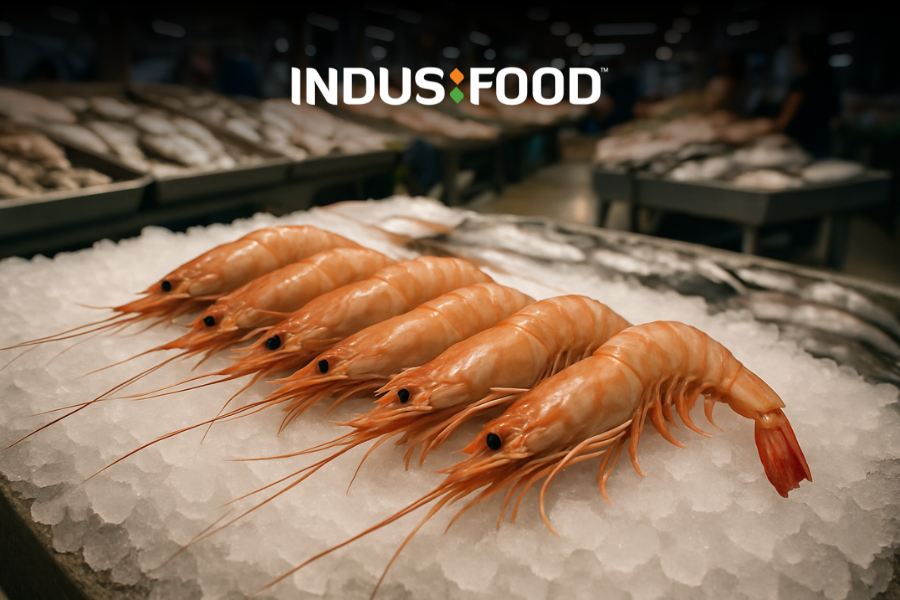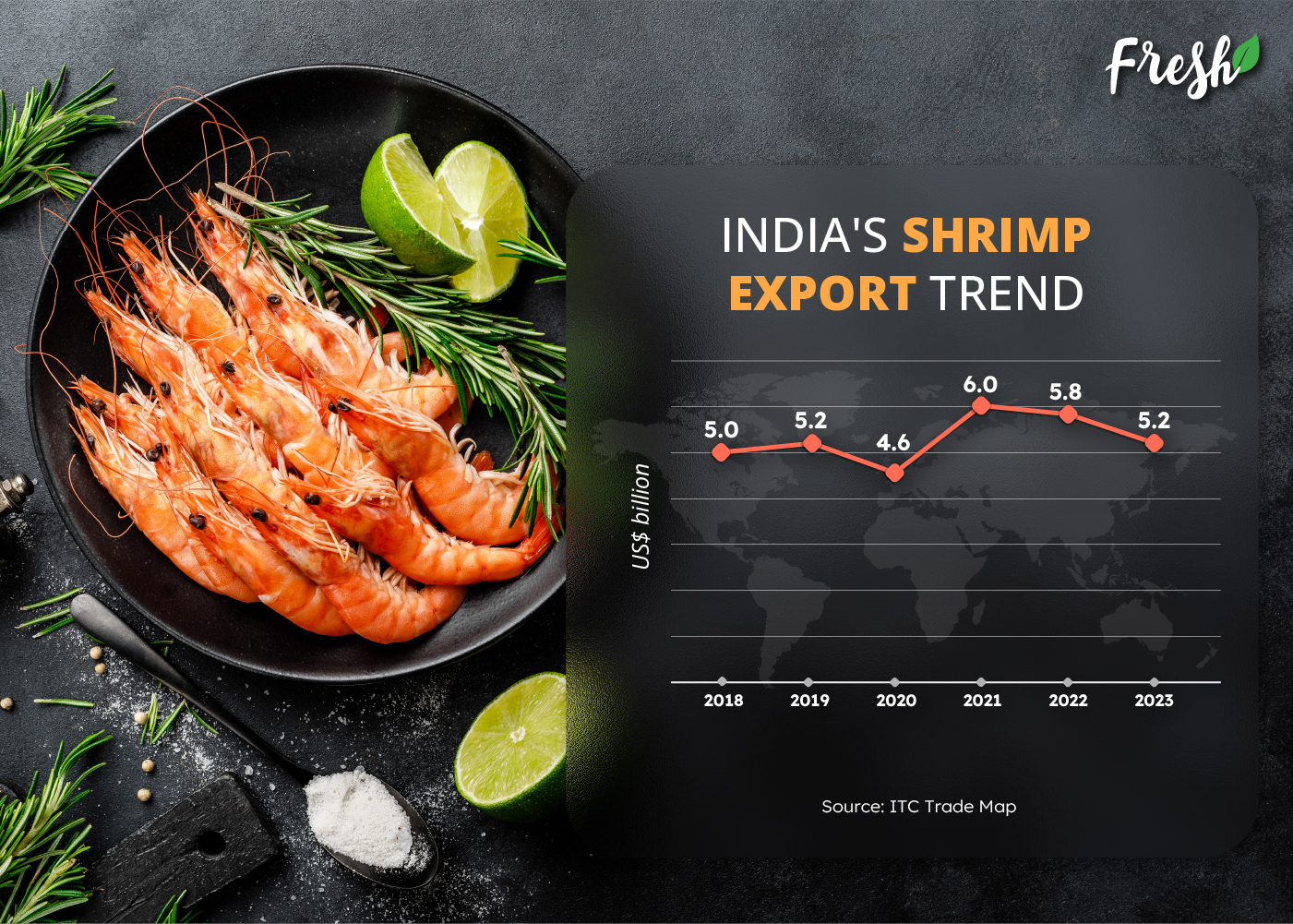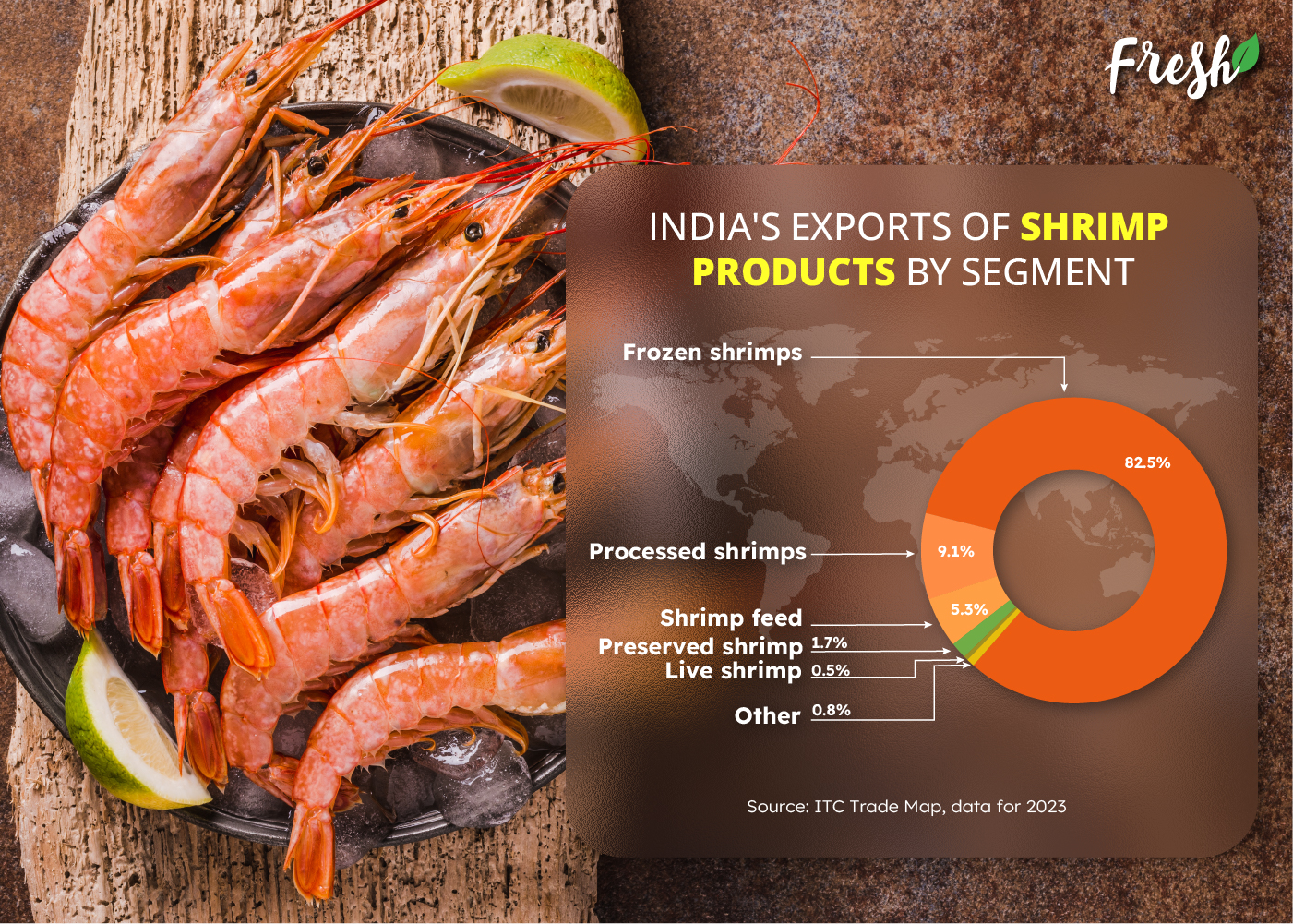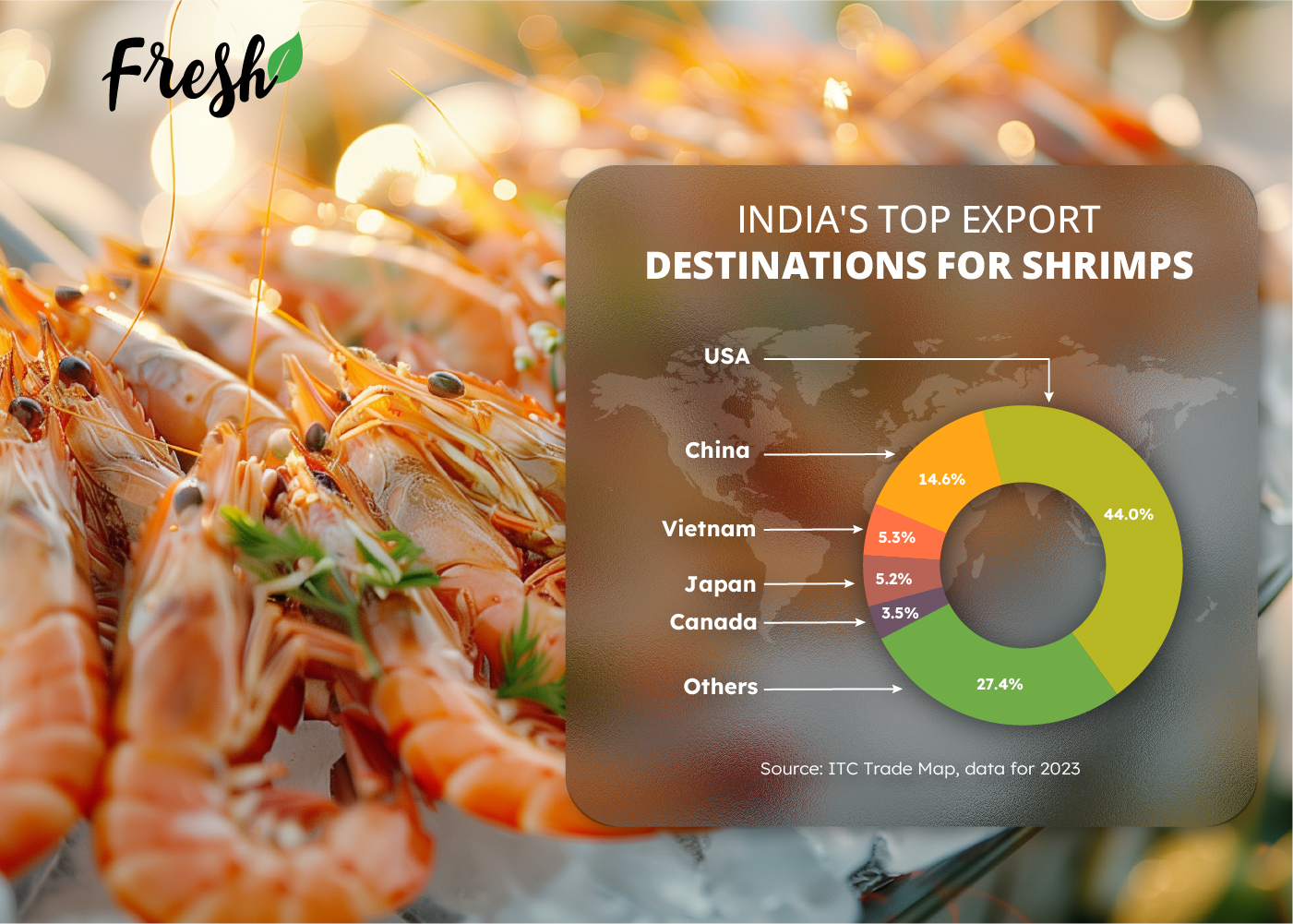
India’s shrimp industry is a cornerstone of its seafood sector, significantly contributing to the nation’s economy. It is valued at approximately US$ 8.3 billion in 2024, with projections to reach US$ 20.9 billion by 2032. India, the second-largest shrimp producer and exporter, saw its exports thrive despite higher duties and global competition, reaching US$ 5.2 billion in 2023. The global shrimp market, valued at US$ 69.22 billion in 2023 and expected to reach US$ 91.23 billion by 2029, presents a significant opportunity for Indian exporters. Rising global demand for healthy seafood, coupled with India’s competitive pricing and advancements in aquaculture technologies, positions the country to capitalize on this booming market, especially in key destinations like the USA, China, and the EU.
Looking ahead, the future of India’s shrimp industry appears bright, driven by the increasing global appetite for high-protein, low-fat seafood. The government’s vision to exceed US$ 14 billion in seafood exports by 2025 is supported by strategic investments in infrastructure and regulations.
Shrimp, with its delicate flavour and versatile cooking properties, has secured its place as a culinary favourite globally. Whether featured in Asian stir-fries, Mediterranean pasta dishes, or classic shrimp cocktails, this crustacean is a beloved ingredient across diverse cuisines. Its popularity is reflected in consumption patterns; it has become the most consumed seafood world-wide, surpassing even canned tuna. The increasing awareness of shrimp’s nutritional benefits, particularly its high protein content and low-fat profile, has further contributed to its culinary acclaim and growing demand globally.
The global shrimp industry has seen remarkable growth, with its market valued at approximately US$ 69.22 billion in 2023, projected to rise at a CAGR of 4.77% to reach US$ 91.23 billion by 2029. This booming sector is underpinned by rising consumer demand for healthy protein alternatives as well as advancements in aquaculture technologies. Notably, global shrimp production surpassed 8 million metric tonnes in 2023, showcasing a trend influenced by evolving dietary preferences and increased trade opportunities.
As one of the largest producers and second largest exporters of shrimp globally, India’s shrimp industry plays a pivotal role in the nation’s economy. In 2024, the industry was valued at around US$ 8.3 billion, with expectations to soar to US$ 20.9 billion by 2032.
According to MPEDA, Andhra Pradesh stands out as the leading producer, accounting for a substantial portion of ~70% in India’s shrimp farming, due to its extensive coastline and favourable climatic conditions. Gujarat is notable for its robust infrastructure and proactive government policies that support aquaculture. West Bengal is famous for its traditional farming practices.
Indian shrimp exporters are expected to see revenue growth of 8-10% this fiscal year as demand from key importing nations recovers and realisations improve, according to Crisil Ratings. This growth will occur despite higher duties for Indian exporters in the United States and locational advantages held by key competing nations.
Crisil noted that higher revenues and lower procurement costs will help sustain an operating margin of around 7%, despite supply chain disruptions and higher logistics costs due to geopolitical uncertainties.
Himank Sharma, Director, CRISIL Ratings, stated, “Indian shrimp exporters stand to benefit as demand improves for two reasons. First, lower channel inventories at importers’ end, who had reduced purchases in the past few months, will need to be replenished. Second, higher spending on discretionary and food items, as the economic outlook improves for Western economies (the key consumers), will drive-up volume and realisations for exporters. Volume and realisations of Indian shrimp exporters will go up in tandem by 4-5% each, driving the revenue growth.”
India is the second-largest exporter of shrimp after Ecuador to the world. India’s shrimp industry export trend has demonstrated resilience. During 2023 India’s shrimp exports valued at US$ 5.2 billion, growing at a CAGR of 0.8%.

Frozen shrimp is the top exported product, it constituted a major portion of 82.5% in the total exports, valued at US$ 4319.1 million in 2023. Secondly processed shrimp exports values at US$ 476.8 million, holding 9.1% share, followed by shrimp feeds, this segment generated US$ 279 million (5.3% share), preserved shrimp (US$ 91.5 million, 1.7% share) and live shrimp (US$ 24.4 million, 0.5% share).

India’s shrimp exports are primarily directed towards the US, which is the top destination, importing approximately US$ 2.3 billion in 2023. China ranks second, with imports of US$ 762.9 million. EU region, Japan and Vietnam, are also importing large quantities from India and boosting its shrimp export landscape. These markets reflect the increasing global appetite for high-quality shrimp, with India positioning itself as a reliable supplier.

India’s shrimp Industry exports are primarily driven by rising global demand for healthy seafood options and advancements in aquaculture technologies that improve production efficiency and sustainability. Additionally, competitive pricing and robust government initiatives further enhance India’s position in the global market.
The Government of India has articulated a vision to enhance the seafood sector, aiming to surpass US$ 14 billion in India’s seafood exports by 2025. This vision is supported by significant financial investments in shrimp farming and processing infrastructure, as well as efforts to harmonize regulations and promote sustainable practices across the industry.
In 2024-25 Union Budget, Finance Minister Nirmala Sitharaman declared Rs. 2,616.44 crore for the Department of Fisheries, a considerable increase from Rs. 1,701.00 crore allocated the previous fiscal year. This is a 54% increase in the department’s overall budget compared to 2023-24.
The Pradhan Mantri Matsya Sampada Yojana (PMMSY) initiative has been given Rs. 2,352 crore for 2024-25, a 56% increase from Rs. 1,500 crore in 2023-24. Aside from the financial allocation, the Finance Minister announced various steps to strengthen the country’s aquaculture sector.
One major measure is a 5% reduction in basic customs duty on broodstock (breeding stock), polychaete worms, and prawn and fish feed. Furthermore, certain materials used in the production of prawns and fish feed would be exempt from customs duties. This decision is likely to boost the business, In which India’s seafood exports worth US$ 7.4 billion in the previous fiscal year. Vannamei prawn exports totalled US$ 3.6 billion. Feed makers incur significant fees due to raw material pricing. Reducing import duties on these materials will allow businesses to increase their profit margins.
While announcing the budget, Ms Sitharaman stated, “I propose to reduce BCD (basic customs duty) on certain broodstock, polychaete worms, shrimp and fish feed to 5%. I also propose to exempt customs duty on various inputs for manufacture of shrimp and fish feed.”
Another option is to provide financial support for the establishment of a network of Nucleus Breeding Centres for Shrimp Broodstock. The government also declared that NABARD would assist financial aid for prawn production, processing, and exports. Given the small margins in these enterprises and the normal 2-3 month working capital cycle, this assistance could be critical in promoting the industry’s growth and stability.
The Marine Products Export Development Authority (MPEDA) has welcomed the latest promises made in the Union Budget 2024-25. According to Mr. D V Swamy IAS, Chairman of MPEDA, the proposed changes will significantly reduce production costs, improve quality, and increase the international competitiveness of Indian marine products.
Looking ahead, the future outlook for India’s shrimp industry is promising, with a projected market value rise to US$ 20.9 billion by 2032. India’s shrimp export sector is poised for significant growth due to a combination of increasing global demand, advanced aquaculture technologies, and supportive government policies. The rising popularity of shrimp-based cuisines and the strong preference for protein-rich seafood are driving consumer demand both domestically and internationally.
Furthermore, the implementation of sustainable practices and technological innovations, such as modern breeding and farming techniques, are enhancing production efficiency and quality, making Indian shrimp more competitive in global markets. With these combined factors, India is well-positioned to solidify its status as a leading shrimp exporter on the world stage.
Read More:
In 2024, India’s shrimp market was valued at approximately US $8.3–9.2 billion, with forecasts to reach between US $20.9 billion by 2032 and up to US $22.7 billion by 2033, growing at a CAGR of around 10%.
In 2023, Indian shrimp exports reached about US $5.2 billion, contributing to seafood exports projected to reach US $12 billion by 2025. Major buyers include the USA, EU, Southeast Asia, China, Japan, Middle East, and the rapidly growing UAE.
India holds approximately 20% of the global shrimp export volume, positioning it as the second-largest shrimp exporter in the world.
The most farmed species are Penaeus vannamei (white-leg shrimp) and Penaeus monodon (black tiger shrimp), with vannamei holding the majority share; monodon is growing fast in premium markets.
Andhra Pradesh is the leading shrimp-producing state (nearly 70%), followed by Gujarat, West Bengal, Odisha, and Kerala.
– High US tariffs (25–26%) limiting exports and compressing margins.
– Flat export volume outlook for FY26 amid sluggish demand in the US, EU, and China—despite modest revenue growth of ~2–3%.
– Labor and environmental issues highlighted by investigations into working conditions and ecological damage
India competes well in value‑added shrimp products (like peeled and cooked items), which make up about 10% of exports today and could grow to 15–17% in the next 2–3 years—helping offset tariff challenges better than raw frozen exports.
The government aims to increase seafood exports from US $8–9 billion to US $12 billion by 2025, with shrimp being a core focus area through emphasis on quality, value addition, and compliance standards.
© Trade Promotion Council of India. All Rights Reserved.